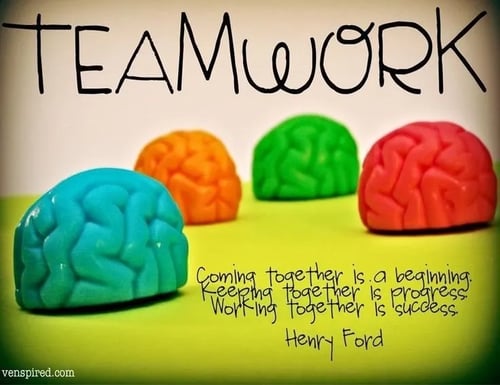We’re Engaged!
‘We’re engaged!’; two words accompanied by a groan and eye roll whilst your wife lets out a shriek and the ‘girls’ whatsapp chat goes wild with excitement and ridiculous giggles that you haven’t heard since your school days! And I’ll stop there; thankfully this is not a blog about putting-a-ring-on-it! Why are more of us not exclaiming ‘we’re engaged’ when it comes to our work lives. Being engaged with your job has so many benefits and I’m not talking about the benefit of lining your boss’s pocket. Worker engagement has huge advantages in terms of positive health and safety climates, employees feeling valued, improving productivity and generally building a happier culture in the workplace. Engagement is different from being ‘involved’ in your organisation. Being involved is often more of a surface-level process; going through the motions of company procedures without having a real vested interest in the firm. For example, telling an employee to report an incident, won’t necessarily mean they care about health and safety, the business or its goals. Worker engagement is far deeper and becomes embedded in thoughts/feelings/behaviour that align with your personal values and attitude. An engaged worker will look proactively for things they can do to support the business where as an involved worker may just use formal procedures as and when they need too (they won’t go above and beyond). So go on, get yourself engaged! Read on for further tips on why worker engagement is beneficial and how you can implement it in your workplace.
Nice to be nice

As humans, we are hard-wired to repay our social debt e.g. if someone does something nice, we feel obliged to do something nice in return and therefore we are more likely to do something nice in the future. This exchange of repayments of a good deed is called the Social Exchange Theory which was coined years ago in the 60’s. This concept develops trusting relationships and equal contributions from each party. Human civilisation relies on this norm of mutual exchange since there would be nothing bonding people together if everyone took what they wanted with no obligation to give back. So in practise, we may see a fantastic boss who is easy to talk to, flexible and generous, therefore we will work hard for him/her and do our best in our role and then in return we may receive an award which incentivises us to continue doing our best/work hard. And so continues this to and fro of ‘nice-ness’ to create a dream-like paradise (well realistically of course it may not be this idealistic but close enough). And just a little tip; we’re obliged to give something back of value to that person e.g. if someone was lactose intolerant, you wouldn’t give them a massive cream cake!
Engagement Sparkler

No, I’m not referring to that huge goodness-knows-what-carat diamond rock that the latest popstar/actress/celeb is wearing; this is all about how engaged employees really does make your workplace sparkle. The best workforces are based on trust, respect and co-operation which are all qualities that worker engagement will bring and help contribute to a positive environment. If workers really become engaged and you have that mutual respect as noted in the Social Exchange Theory, they will come to recognise that they really do play a key part of the business and have valuable ideas and expertise to bring to the table. Within a culture of engagement everyone feels valued as part of the business and has an integral role in creating a high-performing workplace. As well as creating this positive atmosphere for the team’s self-esteem and mindset, engagement has massive benefits for generating a positive health and safety climate. With more than 5550 people losing their life in work place accidents and 159,000 dying from work related illness per year in the EU, placing a big significance on health and safety has never been more important. There is a legal duty for all staff to be involved with health and safety matters. With increased worker engagement, accident rates will drop since staff are aware of the risks, how to control them and how to carry out jobs safely and efficiently. Communication and co-operation are very important aspects of the business and will improve with further engagement. Open communication (whether good or bad) has benefits for health and safety, productivity and workforce loyalty. Stronger engagement levels mean lower absenteeism and more enjoyment in work, with a desire to give back to the business and support objectives.
How do we create a culture of engagement?

It’s a two way process. While leadership plays a large part in setting up frameworks, allocating resources, carving out time for meetings and setting objectives, employees are hugely important as they live and breathe the job and are experiencing the daily health and safety issues. It’s most definitely a collaborative process in which employer and employee work together to spot, solve and own health and safety problems. Managers don’t have all the answers, workers that experience the job will often be able to help find practical solutions and if you are part of finding the solution you are more likely to comply. It also helps to create a culture of open-dialogue, listening to one another’s concerns, sharing views, discussing issues in good time and making decisions together. We must evolve communication from one-way/top-down to two-way ‘top-down/bottom-up’ and ensure all the key messages and feedback are being disseminated clearly and consistently whether it be through emails, meetings, WhatsApps or appraisals. Employees should always be reassured that conversations will be kept anonymous which reinforces the trusting environment. Empowering workers to be involved in decision making and giving them opportunities to upskill shows a commitment to employee health and safety, as well as giving training opportunities and support for growth and development. Allocating roles and responsibilities to team members, empowering them to represent an area is a great way to value employees and establish further engagement. It is important to remember in this process that Rome wasn’t built in a day, it’s not instant and embedding new procedures and processes can take up to 5 years. Creating an engaging environment is a continuing process that needs refining and re-defining; it’s never ‘complete’, always evolving and adapting. Leading by example is also key; being a visible support for co-workers and being seen having regular walkabouts and chats whilst making safety observations without becoming Big Brother. Opinion surveys can be useful to gauge personal feeling, though it is important to value suggestions and act on the results, addressing suggestions and giving feedback which is taken seriously even if it is ‘sorry, we can’t do this at the moment and this is why…’. Suggestion boxes can be a more informal idea for getting regular ideas from the team as well as making sure you recognise achievements whether it be with formal praise or more informal on-the-spot congratulations.
So why isn’t everyone married to the job?

So, whilst engagement in the workplace is of upmost importance, don’t get to the stage that you’re married to the job (that won’t please the wife!). It is all about being engaged and giving that little bit extra whilst maintaining a work-life balance. However, there are some people who really step back and actively disengage for various reasons:
- For some people Health and Safety appears too complex and the legislation can be a minefield
- Some people are just of the mindset that ‘I’m just not interested’
- Others view it as an area for enforcement rather than prevention
- Sometimes lack of experience or perceived ‘too much experience’ causes disengagement
- The terminology is too complicated
- Cumbersome health and safety processes get in the way of quick and efficient work
- Staff are just seen as a number so why should they engage
- Others become complacent in their role and see it as a burden.
Hopefully none of these reasons resonate with you and you can see the benefits of creating an engaging culture whilst also being able to understand, support and hopefully overcome issues of those that are disengaged. So, have a think about your culture of engagement; are your employees engaged? As an employer, do you need to work on establishing a culture where employees can become more engaged? Are there opportunities you can offer? What suggestions do your employees have to cultivate a more engaged workplace? Have those discussions today and get that ‘engagement sparkle’.

